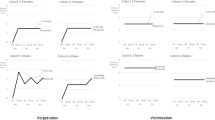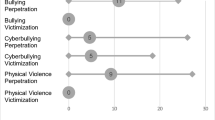Abstract
This study assessed the initial feasibility, acceptability, and efficacy of an intervention aimed at reducing dating violence and sexual risk behavior in a sample of adolescent girls (ages 14–17) with prior exposure to physical dating violence (DV). One hundred and nine girls were randomly assigned to Date SMART (Skills to Manage Aggression in Relationships for Teens) or a Knowledge-only (KO) comparison group. Both intervention arms consisted of six, weekly 2-h sessions and one “booster” session 6 weeks later. Based on principles of cognitive behavioral therapy, the Date SMART intervention was designed to target common underlying skills deficits linked to both DV and sexual risk behavior in adolescent females: depression, self-regulation deficits, and interpersonal skills deficits. Assessments were administered at four time points (baseline, 3, 6, and 9 months). The Date SMART group was effective as reducing sexual DV involvement across the 9-month follow-up period. Both groups evidenced clinically meaningful reductions in physical, emotional, and digital DV involvement, total time in dating relationships, as well as reductions in depression. Findings indicate that delivering a DV and sexual risk prevention intervention to DV-affected adolescent girls is feasible and well-received. Furthermore, a skills-based approach that addresses the co-occurrence of DV and sexual risk behavior may be particularly useful for promoting reductions of sexual DV among high-risk adolescent girls. A future, large-scale trial with an inactive comparison condition is needed to evaluate the efficacy of Date SMART further.
Trial Registration: Clinical Trials, NCT01326195, and http://www.clinicaltrials.gov

Similar content being viewed by others
References
American Psychiatric Association. (2000). Diagnostic and statistical manual of mental disorders (4th ed., text revision). Washington DC: Author.
Beck, A. T., Steer, R., & Brown, G. (1996). Manual for the Beck Depression Inventory-II: Psychological Corporation.
Brown, L. K., DiClemente, R. J., & Beausoleil, N. (1992). Comparison of human immunodefiency virus related knowledge, attitudes, intentions, and behaviors among sexually active and abstinent young adolescents. Journal of Adolescent Health, 13, 140–145.
Brown, L. K., Lourie, K., Zlotnick, C., & Cohn, J. (2000). Impact of sexual abuse on the HIV-risk-related behavior of adolescents in intensive psychiatric treatment. American Journal of Psychiatry, 157, 1413–1415.
Callahan, M., Tolman, R., & Saunders, D. (2003). Adolescent dating violence victimization and psychological well-being. Journal of Adolescent Research, 18(6), 664–681.
Campbell, J. (2002). Health consequences of intimate partner violence. The Lancet, 359(9314), 1331–1336.
Capaldi, D. M., Knoble, N. B., Shortt, J. W., & Kim, H. K. (2012). A systematic review of risk factors for intimate partner violence. Partner Abuse, 3(2), 231–280.
Chase, K. A., Treboux, D., & O’Leary, K. D. (2002). Characteristics of high-risk adolescents’ dating violence. Journal of Interpersonal Violence, 17(1), 33–49.
Clarke, G., Rohde, P., Lewinsohn, P., Hops, H., & Seeley, J. (1999). Cognitive-behavioral treatment of adolescent depression: Efficacy of acute group treatment and booster sessions. Journal of the American Academy of Child and Adolescent Psychiatry, 38(3), 272–279.
Collibee, C., & Furman, W. (2016). Chronic and acute relational risk factors for dating aggression in adolescence and young adulthood. Journal of Youth and Adolescence, 45(4), 763–776.
Cornelius, T., & Resseguie, N. (2007). Primary and secondary prevention programs for dating violence: A review of the literature. Aggression and Violent Behavior, 12, 364–375.
De La Rue, L., Polanin, J. R., Espelage, D., & Pigott, T. D. (2017). A meta-analysis of school-based interventions aimed to prevent or reduce violence in teen dating relationships. Review of Educational Research, 87(1), 1–28.
Eby, K. K., Campbell, J. C., Sullivan, C. M., & Davidson, W. S. (1995). Health effects of experiences of sexual violence for women with abusive partners. Health Care for Women International, 16(6), 536–576.
Eckhardt, C., & Jamison, T. (2002). Articulated thoughts of male dating violence perpetrators during anger arousal. Cognitive Therapy & Research, 26(3), 289–308.
Fals-Stewart, W., Birchler, G. R., & Kelley, M. L. (2003). The timeline followback spousal violence interview to assess physical aggression between intimate partners: Reliability and validity. Journal of Family Violence, 18(3), 131–142.
Finkel, E. J., DeWall, C. N., Slotter, E. B., Oaten, M., & Foshee, V. A. (2009). Self-regulatory failure and intimate partner violence perpetration. Journal of Personality and Social Psychology, 97(3), 483–499.
Forhan, S. E., Gottlieb, S. L., Sternberg, M. R., Xu, F., Datta, S. D., McQuillan, G. M., et al. (2009). Prevalence of sexually transmitted infections among female adolescents aged 14 to 19 in the United States. Pediatrics, 124(6), 1505–1512.
Foshee, V. (1996). Gender differences in adolescent dating abuse prevalence, types, and injuries. Health Education Research, 11(3), 275–286.
Foshee, V. A., Bauman, K. E., Arriaga, X. B., Helms, R. W., Koch, G. G., & Linder, G. F. (1998). An evaluation of Safe Dates, an adolescent dating violence prevention program. American Journal of Public Health, 88, 45–50. https://doi.org/10.1007/s11121-018-0871-z.
Grav, S., Hellzèn, O., Romild, U., & Stordal, E. (2011). Association between social support and depression in the general population: The HUNT study, a cross-sectional survey. Journal of Clinical Nursing, 21(1–2), 111–120.
Houck, C. D., Hadley, W., Barker, D., Brown, L. K., Hancock, E., & Almy, B. (2016). An emotion regulation intervention to reduce risk behaviors among at-risk early adolescents. Prevention Science, 17(1), 71–82.
Johnson, W. L., Giordano, P. C., Longmore, M. A., & Manning, W. D. (2014). Intimate partner violence and depressive symptoms during adolescence and young adulthood. Journal of Health and Social Behavior, 55(1), 39–55.
Leeman, L., Gibbs, J., & Fuller, D. (1993). Evaluation of a multi-component group treatment program for juvenile delinquents. Aggressive Behavior, 19, 281–292.
Lehrer, J., Buka, S., Gortmaker, S., & Shrier, L. (2006). Depressive symptomatology as a predictor of exposure to intimate partner violence among US female adolescents and young adults. Archives of Pediatric Adolescent Medicine, 160, 270–276.
Lescano, C. M., Brown, L. K., Miller, P. M., & Puster, K. L. (2007). Unsafe sex: Do feelings matter? Journal of Prevention & Intervention in the Community, 33, 1/2.
Maldonado, R. C., DiLillo, D., & Hoffman, L. (2015). Can college students use emotion regulation strategies to alter intimate partner aggression-risk behaviors? An examination using I3 theory. Psychology of Violence, 46, 1–14.
McCaffrey, D. F., Ridgeway, G., & Morral, A. R. (2004). Propensity score estimation with boosted regression for evaluating causal effects in observational studies. Psychological Methods, 9(4), 403–425.
Muthén, L. K., & Muthén, B. O. (1998). Mplus User’s Guide (Sixth ed.). Los Angeles, CA: Muthén & Muthén.
Phillips, K. F. V., & Power, M. J. (2007). A new self-report measure of emotion regulation in adolescents: The regulation of emotions questionnaire. Clinical Psychology & Psychotherapy, 14(2), 145–156.
Ramrakha, S., Caspi, A., Dickson, N., Moffitt, T. E., & Paul, C. (2000). Psychiatric disorders and risky sexual behaviour in young adulthood: Cross sectional study in a birth cohort. British Medical Journal, 321, 263–266.
Rao, U., Hammen, C., & Daley, S. (1999). Continuity of depression during the transition to adulthood: A 5-year longitudinal study of young women. Journal of the American Academy of Child and Adolescent Psychiatry, 38(7), 908–915.
Rizzo, C. J., Joppa, M. C., Barker, D., Zlotnick, C., Warren, J., Saint-Eloi Cadely, H., & Brown, L. K. (2017). Individual and Relationship Characteristics of Adolescent Girls with Histories of Physical Dating Violence. Journal of Interpersonal Violence. https://doi.org/10.1177/0886260517696859.
Rubin, D. B. (1987). Multiple imputation for nonresponse in surveys. New York: Wiley.
Schnurr, M., & Lohman, B. (2008). How much does school matter? An examination of adolescent dating violence perpetration. Journal of Youth & Adolescence, 37(3), 266–283.
Silverman, J. G., Raj, A., & Clements, K. (2004). Dating violence and associated sexual risk and pregnancy among adolescent girls in the United States. Pediatrics, 114, e220–e225.
Sussex, B., & Corcoran, K. (2005). The impact of domestic violence on depression in teen mothers: Is the fear or threat of violence sufficient? Brief Treatment and Crisis Intervention, 5, 109–120.
Teitelman, A. M., Dichter, M. E., Cederbaum, J. A., & Campbell, J. C. (2007). Intimate partner violence, condom use and HIV risk for adolescent girls: Gaps in the literature and future directions for research and intervention. Journal of HIV/AIDS Prevention in Children & Youth, 8(2), 65–93.
Thoemmes, F., & Ong, A. D. (2016). A primer on inverse probability of treatment weighting and marginal structural models. Emerging Adulthood, 4(1), 40–59.
Tjaden, P., & Thoennes, N. (2000). Prevalence and consequences of male-to-female and female-to-male intimate partner violence as measured by the national violence against women survey. Violence Against Women, 6(2), 142–161.
Van Buuren, S., & Groothuis-Oudshoorn, K. (2011). MICE: Multivariate imputation by chained equations in R. Journal of Statistical Software, 45(3), 1–67.
Vendetti, K., Stappenbeck, C., & Fals-Stewart, W. (2004). The timeline followback spousal violence interview: A user’s guide. Addiction and Family Research Group. NY: Buffalo.
Whitaker, D. J., Haileyesus, T., Swahn, M., & Saltzman, L. S. (2007). Differences in frequency of violence and reported injury between relationships with reciprocal and nonreciprocal intimate partner violence. American Journal of Public Health, 97(5), 941–947.
Williams, T. S., Connolly, J., Pepler, D., Craig, W., & Laporte, L. (2008). Risk models of dating aggression across different adolescent relationships: A developmental psychopathology approach. Journal of Consulting and Clinical Psychology, 76(4), 622–632.
Wingood, G. M., DiClemente, R. J., Harrington, K. F., Lang, D. L., Davies, S. L., Hook, E. W., & Hardin, J. W. (2006). Efficacy of an HIV prevention program among female adolescents experiencing gender-based violence. American Journal of Public Health, 96(6), 1085–1090.
Wingood, G. M., DiClimente, R. J., McCree, D. H., Harrington, K., & Davies, S. L. (2001). Dating violence and the sexual health of Black adolescent females. Pediatrics, 107, E72–E75.
Wolfe, D., Scott, K., Reitzel-Jaffe, D., Wekerle, C., Grasley, C., & Straatman, A. (2001). Development and validation of the conflict in adolescent dating relationships inventory. Psychological Assessment, 13, 277–293.
Funding
This research was supported by a grant (K23MH086328) awarded to Christie J. Rizzo, Ph.D.
Author information
Authors and Affiliations
Corresponding author
Ethics declarations
Conflict of Interest
The authors declare that they have no conflict of interest.
Ethical Approval
All data collection procedures were carried out with approval from, and in compliance with, the Lifespan IRB at Rhode Island Hospital.
Informed Consent
Informed consent was obtained from all individual study participants.
Rights and permissions
About this article
Cite this article
Rizzo, C.J., Joppa, M., Barker, D. et al. Project Date SMART: a Dating Violence (DV) and Sexual Risk Prevention Program for Adolescent Girls with Prior DV Exposure. Prev Sci 19, 416–426 (2018). https://doi.org/10.1007/s11121-018-0871-z
Published:
Issue Date:
DOI: https://doi.org/10.1007/s11121-018-0871-z




